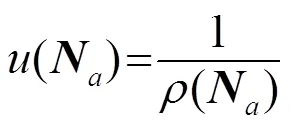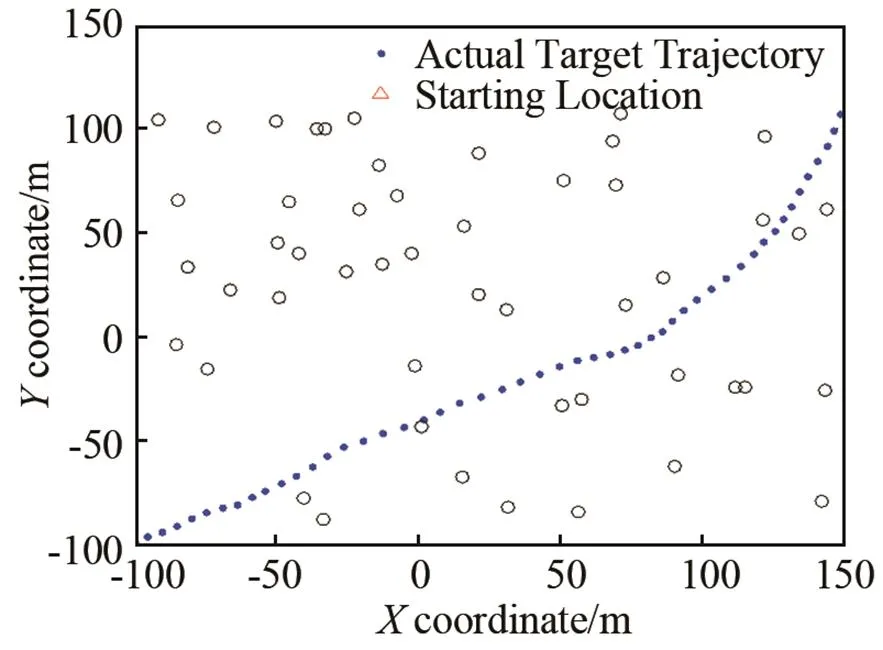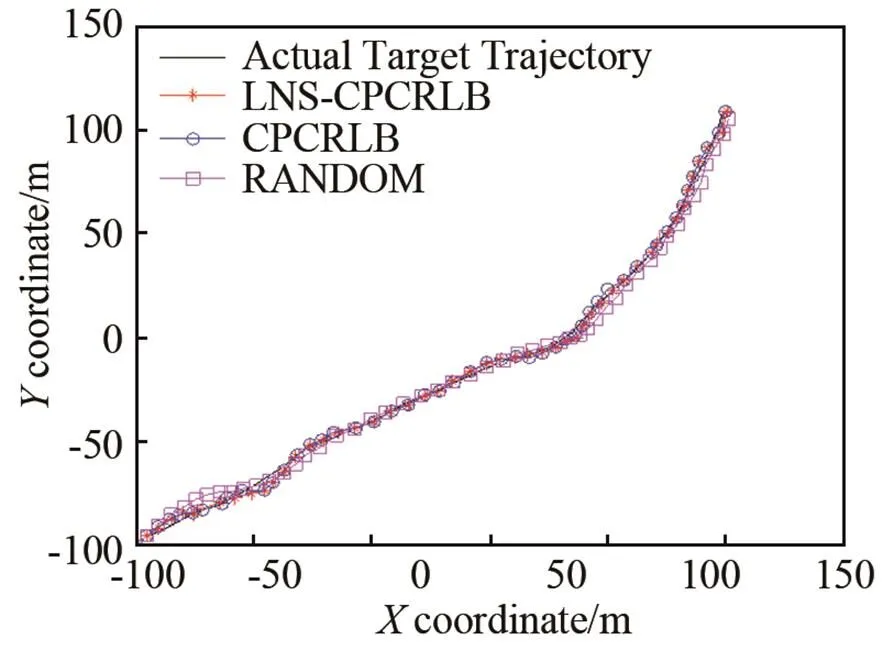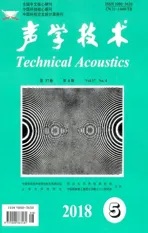CPCRLB based local node selection for passive acoustic target tracking in a distributed sensor network
2018-11-15JIANGXiaoxiaoZHAOXiaoliJINJieDENGChen
JIANG Xiao-xiao, ZHAO Xiao-li, JIN Jie, DENG Chen
CPCRLB based local node selection for passive acoustic target tracking in a distributed sensor network
JIANG Xiao-xiao, ZHAO Xiao-li, JIN Jie, DENG Chen
(School of Electronic and Electrical Engineering, Shanghai University of Engineering Science, Shanghai 201620, China)
For passive acoustic target tracking in a distributed sensor network, this paper proposed a local node selection algorithm based on conditional posterior Cramér-Rao lower bounds (CPCRLB). The approximate analytical expression of CPCRLB is derived by utilizing particle filters for bearing-only measurements, and it is used to define the utility contribution as the node selection criterion. In the proposed algorithm, each node can only use the local information to determine whether to be activated without the knowledge of all nodes in the network. Simulation results prove the effectiveness of our method and show good performance in tracking accuracy, energy consumption and computational complexity.
node selection; posterior Cramér-Rao lower bounds; bearings-only target tracking; particle filter; distributed sensor network
0 Introduction
Wireless sensor networks (WSNs) are information-driven systems that rely on collaboration of randomly deployed sensor nodes. Target Tracking is one of the most important applications in WSNs, which is a target state estimation problem fusing the measurements of sensor nodes. However, the resources of WSNs are extremely constrained. It is unreasonable to allow all nodes to participate in tracking at every time step because of the superfluous energy expenditure. Therefore, an efficient node selection is necessary to make a trade-off between tracking accuracy and energy consumption.
The node selection is an optimization problem to find the best subset of active nodes. F. Zhao et al.[1]propose an information-driven sensor querying (IDSQ) approach to sensor selection. H. Wang et al.[2]present an entropy-based sensor selection heuristic method. G. M. Hoffmann et al.[3]use mutual information as the objective function of sensor management. However, as the information theory methods, their computational complexity becomes very high with the increase in the number of sensor nodes[4]. In recent years, the posterior Cramér-Rao lower bound (PCRLB) attracts much concern of scholars[5]. The PCRLB provides a mean squared error (MSE) lower bound of the target state estimation, but it does not use the actual observation data. L. Zuo et al.[6-7]propose conditional posterior Cramér–Rao lower bounds (CPCRLB). It provides a more accurate and effective online performance limit than PCRLB when the past measurements up to the current time are all known. In order to simplify the calculation, Y. Zhang et al.[8]give a new approximate iteration formula for directly calculating CPCRLB. There has been a lot of researches about node selection for reference[9-13].
In this paper, we consider a distributed system for passive acoustic target tracking and propose a local node selection algorithm based on CPCRLB. The microphone array nodes are used in this system, which can give bearing-only measurements by direction of arrival (DOA) estimations. There is no data processing center for nodes to send their measurements. The advantage of the distributed system is that the failure of one sensor node does not impact the entire system. In the proposed algorithm each node only uses their local node information and does not need the knowledge of all nodes. Therefore, it does not need to recalibrate when nodes burn out or new nodes are added to the network. Moreover, it can reduce most of the communication cost and realize autonomous node selection.
In order to more clearly describe the algorithm, we use the following notations throughout this paper, as shown in Table 1.

Table 1 The notations throughout this paper
1 CPCRLB
1.1 System Model





1.2 Derivation of CPCRLB








Hence,

According to the measurement model (see (2) and (3)), we can get the logarithmic likelihood function as








2 Local Node Selection for Distributed Target Tracking
2.1 Criterion for Node Selection










2.2 Local Node Selection Algorithm
This section describes our proposed node selection algorithm based on CPCRLB for passive acoustic target tracking in a distributed sensor network. It is a local method because the node can only use its local information, the active nodes do not know if any inactive nodes are available.





2.3 Communication Model


The energy of receiving this data is

3 Simulation
In order to demonstrate the performance of the proposed algorithm (labeled as LNS-CPCRLB), we apply it to the distributed sensor network for acoustic target tracking and compare it with the CPCRLB method and the RANDOM method in terms of tracking accuracy and energy consumption. Here, the CPCRLB method for distributed target tracking is a completely greedy search approach to optimal nodes. The RANDOM method uses the random selection of activate nodes.


Fig.1 The flow chart of the local node selection algorithm
From Fig.4, we can see that our proposed algorithm has good performance on the tracking accuracy almost as the CPCRLB method. The CPCRLB algorithm has the best tracking accuracy, because it chooses the best nodes subset from all nodes using exhaustive search strategy. During tracking, the energy consumption of the three algorithms can be calculated by the communication model as previously described. Table 2 shows the statistical average results over 50 snapshots for 100 Monte Carlo simulations and the compu- tations for node selection per snapshot. It can be seen that our proposed algorithm significantlyreduces the energy consumption while maintaining the accurate target state estimation. The CPCRLB and RAN-DOM method have more energy consumption because of the communication between active nodes and all other inactive nodes. Moreover, the total computations for node selection are given in the last column of Table 2.

Fig.2 The target trajectory and the nodes deployment

Fig.3 The tracking results of three different node selection method

Fig.4 The RMSE for tracking on the X axis and Y axis

Table 2 The statistical average results over 50 snapshots

4 Conclusions
This paper proposed a local node selection algorithm based on CPCRLB for passive acoustic target tracking in a distributed sensor network. In order to use the CPCRLB as the node selection criterion, we derive the computational formula of CPCRLB based on bearing-only measurement model, and define the utility contribution of active nodes and inactive nodes. The candidates of inactive nodes can only use their local information to decide the activation by the added utility contribution to the active set. Simulation results prove that the proposed algorithm has good tracking accuracy with less energy expenditure.
[1] ZHAO F, REICH J. Information-driven dynamic sensor collaboration [J]. IEEE Signal Process. Mag., 2002, 19(2): 61-72.
[2] WANG F, YAO K, POTTIE G, et al. Entropy-based sensor selection heuristic for target localization [C]//California: Proc. 3rd International Symposium on Information Processing in Sensor Networks, 2004: 36-45.
[3] HOFFMANN G M, TOMLIN C J. Mobile sensor network control using mutual information methods and particle filters[J]. IEEE Trans. on Automatic Control, 2010, 55(1): 32-47.
[4] YANG X. Sensor selection for target tracking in wireless sensor networks based on performance bounds and quantized data[J]. Acta Electronica Sinica, 2014, 42(6): 1081-1085.
[5] MASAZADE E, NIU R, VARSHNEY P K. Energy aware iterative source localization for wireless sensor networks[J]. IEEE Trans. on Signal Process., 2010, 58(9): 4824-4835.
[6] ZUO L. Conditional posterior Cramér-Rao lower bound and distributed target tracking in sensor networks[D]. NY: Syracuse University, New York, 2010.
[7] ZUO L, NIU R, VARSHNEY P K. Conditional posterior Cramér–Rao lower bounds for nonlinear sequential Bayesian estimation[J]. IEEE Trans. on Signal Process., 2011, 59(1): 1-14.
[8] ZHENG Y, OZDEMIR O, NIU R, et al. New conditional posterior Cramér–Rao lower bounds for nonlinear sequential Bayesian estimation[J]. IEEE Trans. on Signal Process., 2012, 60(10): 5549-5556.
[9] NAYEBI-ASTANEH A, PARIZ N, NAGHIBI-SISTANI M. Adaptive node scheduling under accuracy constraint for wireless sensor nodes with multiple bearings-only sensing units[J]. IEEE Trans. on Aerosp. Electron. Syst., 2015, 51(2): 1547-1557.
[10] JIANG X, HE W, YANG X, et al. An energy-efficient node selection algorithm in bearings-only target tracking sensor networks[J]. International Journal of Distributed Sensor Networks, 2014, 10(2): 1-12.
[11] SHEN X, VARSHNEY P K. Sensor selection based on generalized information gain for target tracking in large sensor networks[J]. IEEE Trans. on Signal Process., 2014, 62(2): 363-375.
[12] KAPLAN L M. Local node selection for localization in a distributed sensor network[J]. IEEE Trans. on Aerosp. Electron. Syst., 2006, 42(1): 136-146.
[13] WANG Y. Adaptive sensor selection for target tracking using particle filter[J]. IET Singal Process., 2014, 8(8): 852-859.
分布式传感器网络中基于条件后验克拉美-罗下界的被动声目标跟踪局部节点选择算法
江潇潇,赵晓丽,金婕,邓琛
(上海工程技术大学电子电气工程学院,上海 201620)
针对分布式传感器网络下的被动声目标跟踪问题,提出了一种基于条件后验克拉美罗下界(Conditional Posterior Cramér-Rao Lower Bounds, CPCRLB)的局部传感器节点选择算法,基于被动声探测背景下的纯方位量测数据,采用粒子滤波器推导得到了CPCRLB的近似解析表达式,进而在该CPCRLB的基础上定义了节点效用贡献作为节点选择准则,结合分布式传感器网络的特点提出了一种局部节点选择方法,节点无需知道全网传感器节点的信息,而是仅利用局部节点信息来决定下一时刻节点的活动状态,从而在实现自治节点选择的同时大大减少网络通信量。通过仿真结果表明,该算法在跟踪精度、能量消耗和计算复杂度方面都表现出较好的性能。
节点选择;后验克拉美罗下界;纯方位目标跟踪;粒子滤波;分布式传感器网络
TN919.2 TP212.9
A
1000-3630(2018)-05-0429-06
10.16300/j.cnki.1000-3630.2018.05.005
2017-10-10;
2017-12-01
National Natural Science Foundation of China (61701295),Foundation for University Young Teacher by Shanghai Municipal Education Committee (ZZGCD15010) and Specific Funds of Subject Building for Shanghai University of Engineering Science (2017PT01).
Jiang Xiaoxiao (1985-), female, was born in Luoyang, Henan province, China. She received the Ph.D. degree in 2014 and now she is a lecturer at Shanghai University of Engineering Science. Her research fields are wireless sensor networks, target tracking and statistical signal processing.
Jiang Xiaoxiao, E-mail: jiangxiaoxiao @sues. edu.cn
